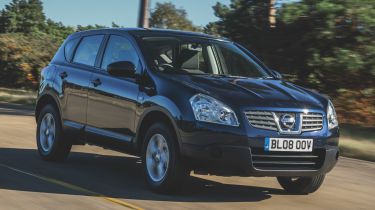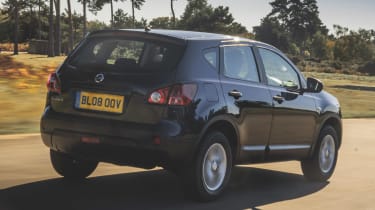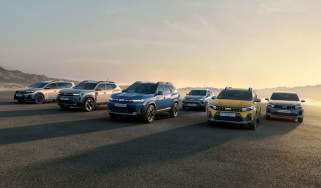Nissan Qashqai (Mk1, 2006-2013) icon review
The Mk1 Nissan Qashqai is the car that kickstarted the crossover craze
Auto Express’ first drive of the Mk1 Nissan Qashqai back in January 2007 was – on the whole – very positive. The car was said to have achieved its aim of slotting between the hatchback and SUV classes, while offering “the best of both worlds”. But in hindsight, its arrival seems to lack fanfare. The Qashqai wasn’t even the main cover car that week, and it was a similar story in other publications at the time.
Of course, we didn’t know then how big a success the Qashqai might be, or the influence it’d have on the car industry. And neither did Nissan. Replacing the Almera hatchback with something very different was deemed a gamble, especially with the firm’s 1999 near-bankruptcy fresh in the mind amidst the Qashqai’s early development.
But the Qashqai wasn’t a completely new idea. Nissan already had the Murano in its line-up, a vehicle which had proven particularly popular in the US. The Qashqai was to be a slightly shrunken take on the Murano.
Toyota, meanwhile, had laid some of the groundwork years earlier with its Mk1 RAV4, while some inspiration for Nissan’s new crossover was taken from the Honda HR-V. In the end, Qashqai nailed the brief better than either car by staying much closer to the hatchback end of the spectrum in its design, but its body shape and ground clearance did enough to capture the appeal of bigger, heavier and more expensive traditional SUVs.
Used - available now

2018 Nissan
Qashqai
45,840 milesManualDiesel1.5L
Cash £11,371
2022 Nissan
Qashqai
35,580 milesAutomaticPetrol1.3L
Cash £15,653
2022 Nissan
Qashqai
41,734 milesAutomaticPetrol1.5L
Cash £19,120
2022 Nissan
Qashqai
23,330 milesAutomaticPetrol1.3L
Cash £18,702In the meantime, it offered more interior space than contemporary C-segment hatchbacks, despite not being a great deal larger on the outside. And although the compact MPVs that were all the rage back then went further still in terms of practicality, it didn’t matter – such cars were much too dull for their own good.
The Qashqai spelt the end for that segment. Wanting a slice of the pie, car manufacturers soon brought out rivals, putting the industry on course for the era of compact SUV domination we now find ourselves in. An increasingly crowded marketplace didn’t stop the Mk1 Qashqai from reaching more than 1.7 million sales by the time production ended in 2013, however. It was a British success story, too, because the car was designed in London, built at Nissan’s Sunderland plant, and a large chunk of the Qashqai’s engineering was completed at the firm’s European tech hub in Cranfield, Bedfordshire.
Not helped by its ubiquity nor its restrained styling, the first-generation Qashqai example we have to revisit today doesn’t do a particularly good job of standing out, blending into the background with a strong sense of anonymity. It’s just part of the furniture on UK roads, just as is the case for the car’s successors. This 2008 Qashqai is part of Nissan’s UK heritage fleet, but despite leading a pampered life in dry storage and having clocked up a below-average 35,000 miles, there’s already some lacquer peel on the paintwork.
The cabin design is basic, with a heavy reliance on hard plastics. It’s an effective demonstration of just how far expectations of interior quality have moved in the decade and a half or so since the original Qashqai’s launch; the current version offers a much more premium space. But it’s all well laid out and we’ve no complaints about the driving position. Most importantly, the amount of additional room compared with a larger contemporary hatchback is immediately clear. There’s plenty of headroom front and rear, decent kneeroom in the rear and a reasonable-sized boot in the Qashqai.
This example has the entry-level 1.6-litre four-cylinder petrol engine (you could also spec a 2.0-litre petrol or diesel unit, the latter eventually replaced with a 1.6), offering a modest 113bhp for a 0-62mph time of nearly 12 seconds. While it doesn’t exactly feel quick off the mark, it doesn’t feel underpowered, either, helped by the Qashqai weighing less than 1,300kg, a figure comparable with the kind of hatchbacks Nissan considered as the car’s main competition.
Refinement is pretty good for what’s now a relatively old unit, although the five-speed manual gearbox has a notchy shift. A CVT was optional for the 2.0-litre petrol engine, while the diesel could be had with a more conventional six-speed automatic, and both the bigger engines got a six-speed manual as standard.
The ride is nice and smooth, and if you start to throw the car around a little (like almost no Qashqai owners ever will, admittedly), it feels surprisingly tidy. Body roll is well contained, and there’s more than enough grip on offer. It even has good steering, which feels surprisingly direct and is spot on in terms of weight. Not bad for an early electric power-assisted set-up.
All of this can be enjoyed from that elevated driving position buyers of these cars love so much, with that extra height seemingly coming at minimal cost to the dynamics. While a Mk1 Qashqai is never going to truly excite behind the wheel, you can’t help but appreciate how complete a package it is. This is a well executed car that’ll slot into your life quite nicely.
Nissan replaced the original ‘J10’ Qashqai in 2013 with the ‘J11’, which helped the model breach three million total sales in 2018. The ‘J12’ Mk3 version arrived in 2022, and quickly proved popular, too, topping the UK’s car sales charts in
the year of its launch. That’s despite the car having slipped back relative to much of the competition.
The whole industry is now geared towards making high-riders of all shapes and sizes. Would that have happened without the Qashqai or was this craze inevitable? We’ll never know for sure, but the far-less- successful Honda HR-V suggests the genre was awaiting the right car to truly kick it off, and that came in the form of this Nissan. The question is: do you thank the Qashqai or blame it for where we are now?
What we said then
- Issue 944, 17-23 January 2007
“Offering greater space than a regular hatchback, but more compact and manoeuvrable than an SUV, the Qashqai really is the best of both worlds. It rides and handles as well as leading hatch rivals, but from behind the wheel the driver gets a more commanding view of the road. It’s practical, too, with a good boot, and a top-class interior, which offers generous head and legroom for five people.”
Interested in buying one?
Unlike a lot of the cars featured in our Icons series so far, you definitely won’t have a problem finding a Mk1 Qashqai in the classifieds. Being a reasonably recent and wildly popular car, there are hundreds to choose from.
Prices start from less than £2,000, but for that sum, you’ll likely have to settle for a high-mileage car in base-spec Visia trim with the entry-level 1.6-litre petrol engine. Spend around £3,000-4,000, and you’ll be able to get a 2.0-litre example (or the more economical diesel of the same capacity) with fewer miles on the clock and either the mid-spec Acenta grade or the top-of-the-range Tekna trim.
All-wheel-drive models are rare, but in any case, front-wheel drive makes more sense for most buyers. Also scarce is the stretched Qashqai +2 seven-seater model, which is only worth considering if you’ll be sitting very small children in the third row, because it’s cramped back there.
The first-generation Qashqai isn’t as well built or reliable as you might expect, and the last time the Nissan featured in our Driver Power ownership survey, in 2016, it finished three places from last position. Common issues include premature rear damper failure and faulty ignition barrels.
As with any used car, it’s important to check service intervals have been adhered to. These are every year or 12,500 miles, alternating between minor and major. The only engine to feature a cambelt is the 1.5-litre dCi diesel, which requires renewal every 100,000 miles or six years.
| Model: | Nissan Qashqai Mk1 |
| Production dates: | 2006-2013 |
| Price then: | From £15,945 |
| Price now: | From £2,000 |
| Engine: | 1.6-litre 4cyl turbo petrol, 113bhp |
| Transmission: | Five-speed manual, front-wheel drive |
| 0-62mph: | 11.6 seconds |
| Top speed: | 109mph |






